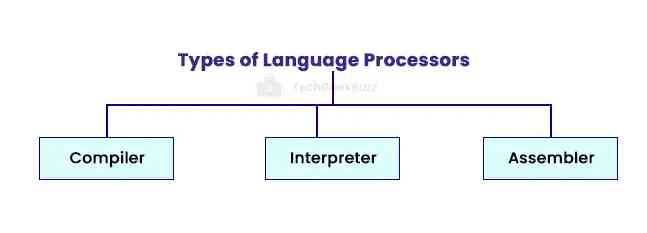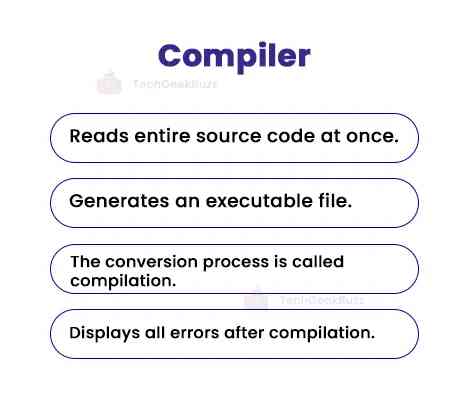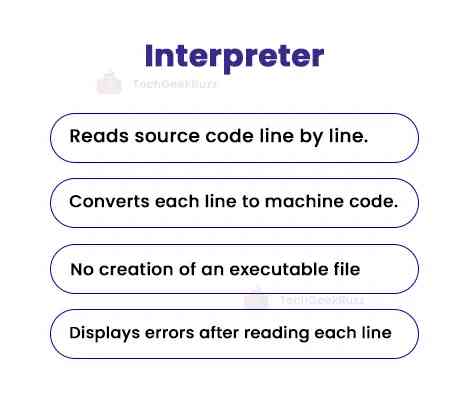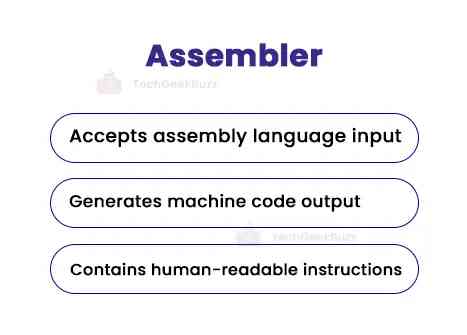A language processor is a special software program that converts the code written in any high-level programming language into intermediate or machine code. If you are a novice learning to write computer programs, you must be aware of it. Read this article to gain knowledge of the language processor and its functioning.
Computers and other electronic devices can understand and interpret only binary data , the sequence of 0s and 1s. They cannot comprehend and execute instructions written in high-level programming languages , such as C, C++, Java, Python, etc., called the source code. This is where the role of a language processor comes into play.
A language processor translates the source code into machine code, making it possible for computers to execute and generate the output.
This blog post aims to enlighten you on the concept of the language processor and its types.
What is a Language Processor?
A language processor is a special software that converts a program written in high-level or assembly language into machine code.
Computers can interpret and execute only machine code, i.e., instructions in the form of 0s and 1s. In addition, it becomes extremely challenging and intimidating for programmers to write programs in machine code. Hence, a language processor bridges the gap between programmers and computers.
The language processor takes the source code (programming statements or instructions written by programmers) as input and generates its equivalent machine code as output. Computers can understand this machine code, execute it easily, and generate the desired output.
While translating, the language processor also highlights errors in the source code. Hence, it becomes easy for programmers to debug their source code.
Types of Language Processors

There are three types of language processors - compiler, interpreter, and assembler. Let us discuss their functions in detail below.
1. Compiler

A compiler is a language processor that reads the source code (a program written in any high-level programming language) in one go and translates it all at once into machine code or bytecode. The output of a compiler is an executable file run by a computer to display the output.
The process of converting the source code into the equivalent object code or machine code using a compiler is called compilation.
A compiler displays all errors at once after the process of compilation, if any. It highlights errors with line numbers to help you locate errors in the source code easily. Once all errors are fixed, the compiler recompiles it and converts it into an executable program if there are no errors.
This process of compilation takes place in different phases. It involves checking the source code syntactically and semantically, generating and optimizing the intermediate code, and converting it into object code.
Programming languages that need a compiler for execution are referred to as compiled programming languages. Examples include C, C++, C#, ALGOL, Basic, and Carbon.
Read more about a compiler in detail here .
Features of a Compiler
- A compiler translates the source code into machine code in one go.
- It creates an executable file for a computer to run and display the output.
- The compiled code runs faster than the interpreted code.
- As it reads an entire source code in one go, it displays all errors after compilation.
-
The process of compilation takes place in the following phases:
- Lexical analysis
- Syntax analysis
- Semantic analysis
- Intermediate code generation
- Code optimization
- Code generation
- The executable file is a standalone file that runs without requiring the source code.
Advantages and Disadvantages of a Compiler
The following table displays the advantages and disadvantages of a compiler:
|
Advantages |
Disadvantages |
|
|
2. Interpreter

An interpreter is another popular type of language processor that reads the source code line by line, converts it into the intermediate form, and executes it directly. Unlike a compiler, the interpreter does not create an executable file. Instead, it directly translates the source code into the target code (machine code) line-by-line.
If a specific line of source code has errors, the interpreter displays errors before moving on to the next line for execution. This implies the interpreter stops the execution of an entire program when it finds errors or bugs.
Once the error is fixed, it translates that line into the target code and starts executing the next line. This line-by-line execution makes debugging easier.
Programming languages that leverage an interpreter for execution are referred to as interpreted programming languages. Examples include Python, JavaScript, Perl, PHP, and MATLAB.
Read more about an interpreter in detail here .
Features of an Interpreter
- An interpreter executes the source code line by line.
- It stops executing a program when it encounters an error in any line of code.
- It does not include any compilation process. Hence, an executable file is not generated.
- The interpreter works slower than a compiler as it reads and executes each line.
Advantages and Disadvantages of an Interpreter
The following table displays the advantages and disadvantages of an interpreter:
|
Advantages |
Disadvantages |
|
|
3. Assembler

An assembler is a language processor that translates programs written in an assembly language into machine code. It accepts programs in assembly language as input and generates an equivalent machine code as output, which is executable by a computer.
The assembly language is a type of low-level programming language that is close to a computer’s hardware. Though it is a low-level language, it consists of instructions that humans understand, not computers. It uses keywords like ADD, MUL, SUB, DIV, etc., which resemble English words. Hence, humans find it easy to comprehend programs in assembly language.
An assembler converts this low-level language into machine language, enabling computers to execute it.
Features of an Assembler
- An assembler supports directives and macros.
- It also displays errors in the source code.
- It is designed specifically for hardware architectures.
Advantages and Disadvantages of an Interpreter
The following table displays the advantages and disadvantages of an interpreter:
|
Advantages |
Disadvantages |
|
|
Conclusion
This was all about the language processor. The language processor plays a vital role in bridging the gap between a computer and its users. It translates all high-level instructions or programs into machine language, understandable and executable by computers. Without language processors, it would be daunting for programmers to write a program in machine code consisting of only 0s and 1s.
We hope this article was able to help you understand what a language processor is and its different types. If you have any queries, let us know in the comments.
People are also reading:


![What is an Assembler? [Definition, Working, & Types]](/media/new_post_images/What_is_Assembler.jpg)
![What is I/O? [Types, Examples, & Methods]](/media/new_post_images/What_is_I_O.webp)

Leave a Comment on this Post